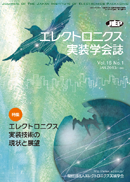Volume 16, Issue 6
Displaying 1-18 of 18 articles from this issue
- |<
- <
- 1
- >
- >|
Preface
-
2013Volume 16Issue 6 Pages P6
Published: 2013
Released on J-STAGE: December 03, 2013
Download PDF (745K)
Special Articles / Looking Back on the Packaging Technology
-
2013Volume 16Issue 6 Pages 421
Published: 2013
Released on J-STAGE: December 03, 2013
Download PDF (808K) -
2013Volume 16Issue 6 Pages 422-427
Published: 2013
Released on J-STAGE: December 03, 2013
Download PDF (1822K) -
2013Volume 16Issue 6 Pages 428-432
Published: 2013
Released on J-STAGE: December 03, 2013
Download PDF (1484K) -
2013Volume 16Issue 6 Pages 433-437
Published: 2013
Released on J-STAGE: December 03, 2013
Download PDF (1233K) -
2013Volume 16Issue 6 Pages 438-442
Published: 2013
Released on J-STAGE: December 03, 2013
Download PDF (1496K) -
2013Volume 16Issue 6 Pages 443-449
Published: 2013
Released on J-STAGE: December 03, 2013
Download PDF (1639K)
2013 JIEP Award–Technical Development
-
2013Volume 16Issue 6 Pages 450-456
Published: 2013
Released on J-STAGE: December 03, 2013
Download PDF (2647K) -
2013Volume 16Issue 6 Pages 457-462
Published: 2013
Released on J-STAGE: December 03, 2013
Download PDF (2059K)
Technical Paper
-
2013Volume 16Issue 6 Pages 463-469
Published: 2013
Released on J-STAGE: December 03, 2013
Download PDF (1982K) -
2013Volume 16Issue 6 Pages 470-476
Published: 2013
Released on J-STAGE: December 03, 2013
Download PDF (1795K) -
2013Volume 16Issue 6 Pages 477-483
Published: 2013
Released on J-STAGE: December 03, 2013
Download PDF (2264K) -
2013Volume 16Issue 6 Pages 484-491
Published: 2013
Released on J-STAGE: December 03, 2013
Download PDF (2060K)
Report
-
2013Volume 16Issue 6 Pages 492
Published: 2013
Released on J-STAGE: December 03, 2013
Download PDF (831K)
Announcement, Contents, etc.
-
2013Volume 16Issue 6 Pages 494-496
Published: 2013
Released on J-STAGE: December 03, 2013
Download PDF (959K) -
2013Volume 16Issue 6 Pages A61-
Published: 2013
Released on J-STAGE: December 03, 2013
Download PDF (1915K) -
2013Volume 16Issue 6 Pages C61
Published: 2013
Released on J-STAGE: December 03, 2013
Download PDF (729K) -
2013Volume 16Issue 6 Pages C62
Published: 2013
Released on J-STAGE: December 03, 2013
Download PDF (651K)
- |<
- <
- 1
- >
- >|
